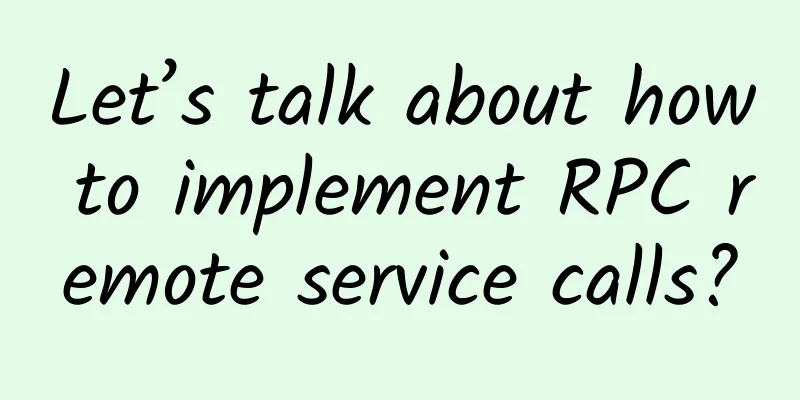Let’s talk about how to implement RPC remote service calls?

OverviewIn the previous article, I introduced how to complete a service call, especially how the service consumer obtains the address of the service provider, in which the registration center plays a key role. The service provider registers its address to the registration center, and the service consumer queries the registration center to obtain the address of the service provider, which is like a lighthouse on the sea, guiding the service consumer. After obtaining the address of the service provider, the service consumer can initiate a request to the address. However, after the service split, the service provider and service consumer run in different processes on different physical machines. This call is called a remote method call (RPC). So, how is the RPC call implemented? Establishing a network connectionImagine the process of making a phone call. Caller A finds the phone number of callee B by looking up the phone book, and then dials B's phone. If B is available to answer, he will answer. If not, A needs to wait. After a certain period of time, the call will be hung up due to timeout, and A needs to call again. The principle of RPC call is similar. The client and server must first establish a network connection and communicate according to the protocol. After the connection is established, the server processes the request when it receives it and returns the result to the client. In order to reduce the amount of data transmission, the data also needs to be compressed, that is, serialized. How do the client and server establish a network connection?The client and server establish a network connection based on the TCP protocol. There are two common ways:
Network exception handlingAfter the network connection is established, network disconnection, connection timeout, server downtime and other anomalies are common. There are usually two ways to deal with them:
How does the server process the request?There are three ways for the server to process client requests:
Data transmission protocolThe protocol used for data transmission is one of the keys to RPC calls. Commonly used protocols include HTTP and customized private protocols (such as Dubbo). Whether it is an open or private protocol, a "contract" must be defined. The service consumer encodes the data according to the contract, and the service provider decodes the data according to the contract, and encodes the returned result after processing. Data serialization and deserializationSerialization is the process of converting data structures into byte sequences, which reduces the size of transmitted data and improves transmission efficiency. Common serialization methods include text-based (such as XML/JSON) and binary-based (such as PB/Thrift). The selection of serialization methods mainly considers the richness of data structure types, cross-language support, and performance. Communication FrameworkThe complete RPC call framework includes the communication framework, communication protocol, serialization and deserialization. The communication framework solves the connection management and request processing problems, the communication protocol solves the data transmission protocol problem, and serialization and deserialization solve the data encoding problem. It is recommended to use mature open source solutions such as Netty and MINA, which have been proven reliable in large-scale applications. SummarizeRPC calls need to solve four problems: network connection, request processing, data transmission protocol, data serialization and deserialization. The complete RPC call framework consists of communication framework, communication protocol, serialization and deserialization. Mature open source solutions such as Netty and MINA are safe choices. Questions for considerationgRPC is an excellent cross-language RPC calling framework. What are its advantages? First of all, gRPC supports multiple programming languages, including C++, Java, Python, Go, Ruby, PHP, Node.js, C# and Dart, making it very flexible and powerful in cross-language communication. Secondly, gRPC is based on the HTTP/2 protocol and has high-performance features such as multiplexing, flow control, and header compression, which greatly improves data transmission efficiency. It uses Protocol Buffers for efficient binary serialization, further reducing the overhead of data transmission. gRPC also simplifies the development process. By defining the interface with Protocol Buffers, client and server code can be automatically generated, reducing the workload and error risk of manual code writing. Strongly typed interface definitions ensure the consistency and type safety of the interface between the client and the server. In addition, gRPC supports bidirectional stream communication and streaming processing, allowing clients and servers to exchange multiple messages in a single connection, which is very suitable for real-time communication and complex interaction scenarios. In terms of security, gRPC has built-in support for TLS/SSL encryption and provides multiple authentication methods to ensure the security of data transmission and access control. gRPC also supports load balancing and service discovery functions, and can be integrated with service discovery systems such as Consul, Etcd, and ZooKeeper to achieve high availability and scalability. Finally, gRPC provides rich monitoring and tracing capabilities to facilitate performance monitoring and troubleshooting of services, and can be integrated with monitoring and tracing systems such as Prometheus and Jaeger. In short, gRPC has outstanding performance in performance, cross-language support, development efficiency, security, load balancing and monitoring, and is an excellent cross-language RPC call framework. |
Recommend
RAKsmart cloud server 30% off + first month half price, popular cloud server 10% off annual payment from 79 yuan, Hong Kong/Japan/US data center
In addition to VPS and dedicated servers, RAKsmar...
A Complete Analysis of IPv6 Transition Technology
The IPv6 wave is coming With the rapid developmen...
Short Video Technology Guide: Evaluation of the Top 5 Short Video Solution Providers in China
Statistics from 2016 show that the average daily ...
Low Power Wide Area Network (LPWAN) Shapes the Future of IoT
IoT wireless connectivity networks are booming to...
Multi-cloud, security integration drives mass SD-WAN adoption
SD-WAN is expected to grow 40% year-over-year thr...
Inventory: 11 foreign SASE vendors
SASE (Secure Access Service Edge) is a networking...
ProfitServer 50% off all VPS from $2.88/month, Hong Kong/Singapore/Russia/Spain/Netherlands/Germany and other data centers
ProfitServer is a foreign hosting company founded...
5G and its impact on the Internet of Things
Not surprisingly, the digital world is gradually ...
Internet medical care is emerging. Should HIS be "repaired" or "completely reconstructed"?
During the COVID-19 outbreak, Internet medical se...
The first openEuler Summit was held online: Creating a better operating system for diverse computing scenarios
[51CTO.com original article] [China, April 17, 20...
H3C Ao Xiangqiao: SD-WAN will eventually move towards a high-level self-intelligent network
SD-WAN became a "hot word" in China in ...
It may be too early to claim that 5G package user development has cooled down
[[384501]] The three major operators all released...
HostingViet: Vietnam VPS annual payment 50% off 161 yuan/year, 1GB/20G SSD/unlimited traffic
HostingViet, a local host provider in Vietnam, wa...
Among China Mobile, China Unicom and China Telecom, which 100M broadband is more reliable and cost-effective?
Currently, 100M fiber-optic access to homes has b...
[6.18] DediPath: $30/month-E3-1240v2, 16GB memory, 2TB hard disk, 1Gbps unlimited traffic/Los Angeles data center
DediPath launched a Father's Day Sale. Becaus...









